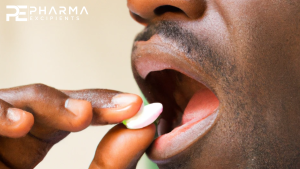Mucoadhesive aprepitant-loaded nanostructured lipid carriers containing sulfhydryl surfactant for enhanced oral drug bioavailability

The objective of the study was to design mucoadhesive drug-loaded nanostructured lipid carriers (NLCs) for enhancing the bioavailability of a model BCS Class IV drug aprepitant (APT). For this purpose, polyethoxylated surfactant (polyoxyethylene 20 oleyl ether) was thiolated, and mucoadhesive NLCs were designed through nano-template engineering technique using thiolated surfactant, Span 60 (lipophilic surfactant), labrasol (hydrophilic surfactants), miglyol (liquid lipid), stearic acid (solid lipids), and PEG 6000 as a stabilizer. Mucoadhesive NLCs were characterized via size, ζ (zeta potential), polydispersity index (PDI), and scanning electron microscopy (SEM).
Highlights
- Polyoxyethylene 20 oleyl ether was thiolated to generate aprepitant-loaded mucoadhesive NLCs through nano-template engineering technique.
- Mucoadhesive NLCs were characterized and evaluated for drug loading, entrapment, stability, safety, in-vitro drug release, mucoadhesion, and permeation studies.
- In-vivo studies were conducted to prove enhanced oral bioavailability of drug.
- Mucoadhesive NLCs showed improved mucoadhesive, and 24.8 % enhanced relative bioavailability.
- On the basis of all the above-stated findings, it can be decided that drug-loaded mucoadhesive NLCs are suitable nanocarriers for delivering the aprepitant orally.
Moreover, NLCs were evaluated for drug loading capacity and entrapment efficiency, stability, safety, drug release, mucoadhesion, and permeation studies. Furthermore, in-vivo studies were conducted on Sprague-Dawley rats to prove enhanced oral bioavailability of APT. The APT-loaded NLCs revealed a particle size of 185 ± 12 nm, zeta potential of about −23.5 ± 3 mV, a PDI of 0.190 ± 0.01, having spherical shape, with 6.7 ± 0.8 % and 86 ± 3 % drug loading and entrapment efficiency, respectively. The APT-loaded NLCs were found stable at different conditions and demonstrated the sustained release of the drug. NLCs were found safe as more than 80 % cells were found viable after 24 h.
Moreover, drug-loaded mucoadhesive NLCs showed 3.8-fold improved mucoadhesive properties as compared to control. Mucoadhesive NLCs were found less permeable due to disulfide bond formation with mucus. In-vivo studies confirmed that APT-loaded mucoadhesive NLCs exhibited 2.56-fold improved Cmax. Furthermore, 24.8 % relative bioavailability (Fr) was reached for APT-loaded mucoadhesive NLCs as compared to 9.8 % for APT suspension. On the basis of all the above-stated findings, it can be decided that these NLCs are suitable nanocarriers for delivering the aprepitant orally.
Read more here
Matearials
Triphyenylphosphine (Ph3P), N-bromosuccinimide (NBS), dichloromethane (CH2Cl2), lithium bromide (LiBr), thiourea, Span 60, polyethylene glycol 6000 (PEG 6000), stearic acid, Ellman’s reagent were purchased from Merck, USA. Diethyl ether and dimethylformamide (DMF) were purchased from Riedel-de-Haen, Germany. Labrasol was kindly denoted by Gattefosse, France. Aprepitant (APT-534 g/mol) was kindly donated by Ferozsons Laboratories Limited, Pakistan. Polyoxyethylene (20) oleyl ether (Brij 98).
Ahmed Raza Hashmi, Eyman Mohamed Eltayib, Muhammad Naeem Qaisar, Duaa Abdullah Bafail, Esmaeil Salimi, Shumaila Arshad, Mavra Rubab, Alamgeer, Farwa Zahra, Sidra Yasmeen, Mulazim Hussain Asim, Mucoadhesive aprepitant-loaded nanostructured lipid carriers containing sulfhydryl surfactant for enhanced oral drug bioavailability, Journal of Drug Delivery Science and Technology, Volume 98, 2024, 105904, ISSN 1773-2247, https://doi.org/10.1016/j.jddst.2024.105904.
Read also our introduction article on Orally Disintegrating Tablets (ODTs) here:


